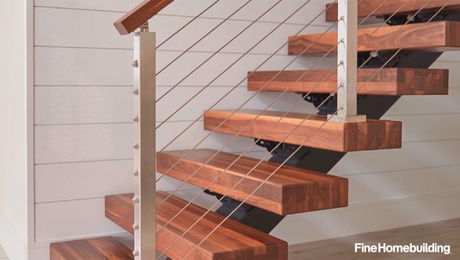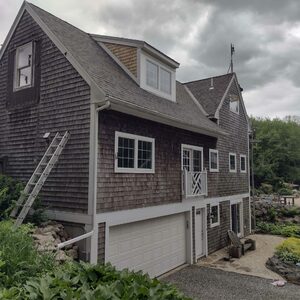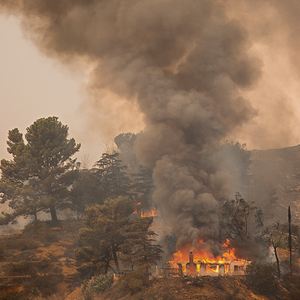Am about to re-do a spring on land I own in southern Ohio as it seems there is a lot of run-off ground water getting into the system.
The previous owner (as far as I can tell) has a four inch PVC pipe sitting in a gravel bed behind a sandstone dam…it’s in a ravine against a steep hillside. This is where he captured the spring. The catch basin is small, maybe 18″ square.
From there he ran PVC (with the holes in it) underground (4 inches or so) about 20 yards downhill to a crock.
The holed PVC runs alongside and through the run-off creek enabling it to draw in polluted water.
I need more info ?? as I’m in the dark as to the proper capping of springs. The flow averages about two gallons a minute and varies greatly when it rains hard.
Any help would sure be appreciated……….



















Replies
Maybe a cooperative extension office could assist you? (I think they're a part of the Ag dept.?) Or county sanitation engineer (if you have such). We have all sorts of laws governing water and a sanitation guy has to come out and check all wells and septic systems. They should be able to advise you, but maybe your state is different.
Around here it's pretty much do as you please . . . for instance this house I'm building needs no inspections..........if I call in the county engineers......they'd probably say we don't advise on spring fed water systems because they change with the weather etc.........Although there are a lot of them in these hills
I can do this on my own, but it never hurts to ask for opinions from other builders who are more experienced with springs. There is no industry anywhere in the vicinity and I plan on getting the water tested once I have the spring capped properly....then a little house and all.
I'm alson wondering what would be the best in-house filtering system for spring water???
The post from Bill Harmann has good advice. As far as filtration; I guess once you get the tests, you'll find out what and how much you'll need to filter. We have an artesian well on our property where we hunt and do nothing to the water. I'm sure there are sand filters and activated charcoal filters and filters with colloidal silver, but it depends on what you need to take out.
Do you want to CAP it are TAP it?
I get mixed message about whether you want to just channel the water away or you want to make use of the water.
If you want to use it want more needs to be done that replace the preforated pipe with solid?
There should be lots of information around about springs. Specially in older publications from the Agriculture Extension office. When I was a kid I had some Pop Mechancis from the 30's or 40's and there where all kinds of articles in it. And probably in the Mother Earth and Foxfire type of books.,
A google - spring fed water systems - got lots of hits. Some of them good others strange like for a water cooled machine gun. You might want to try some other combinations like -spring feed domistic water supply -.
I've developed spring water a few times. There is a great book called Waterworks: A Guide to Rural Water Systems that has all the info you need. I hear that it's out of print, but it used to be sold by Real Goods. I "own" a copy, but loaned it to a guy who turned out to be a complete #######. He says he has it, but won't return it.
From what I understand: There shouldn't be any surface water draining to the spring. Preventing that often requires substantial digging. I developed one in Montana (when I was younger and thought it no big deal to spend days in the woods with a pick and shovel) by digging a trench all the way around the spring, stood a 7' x 48" diameter piece of galv culvert over the spring, ran a poly pipe out the bottom down to the cabin, backfilled around the pipe, built a cover for the top and had good clean water.
Is your spring in a spot where you can get a backhoe in? Is the bottom clay or rock?
It could be simpler to install a complete purification system than to redo the spring catch...
I'll be glad to help more if you want.
You're unique! Just like everyone else! Scott Adams
Is your spring in a spot where you can get a backhoe in? Is the bottom clay or rock?
No, it's a narrow, wet, fern covered ravine at the foot of a (maybe 1000 ft high) pretty steep hill. There is a lot of both clay and rock. There are two large sandstones that seem to have been placed there to create a dam. The PVC goes in under them. I found a secondary spring hole a couple of feet away from the pipe that had a large crayfish pop out of it.
Whatever I do will be by hand, but I am digging a hole and burying a holding tank back a bit where I can get the hoe in. I am a bit afraid of mucking up the works around the spring and losing the water as this will be THE source for the house I'm building. I'm researching the net and asking questions where ever I can and will look for the book........thanks to all.
JJ,
You wouldn't happen to be my neighbor, would you ? LOL
Let me describe my situation.
I live on the north side of a steep ridge. I doubt if it is 1000 feet high. But it's pretty far up there. It is a foothill to the mountain.
There is a lot of underground water on this side of the ridge. We have had several major slides since I have lived here. Mostly off to the west of me, toward sunset falls.
It's a wet place. Wetter than most. Because all the clouds come in and gather here. Letting off enough water to become light enough to get over the rest of the mountains. Seattle, and all the rest of the area between here and the coast sees every cloud I do. But they only drop rain as they are passing over them. All those same clouds come here and sit and gather. All of them letting out their moisture. Even the ones that didn't rain on the good people of Snohomish or Monroe
Anyway, It's a wet place. We only get fairly dry in the late summer and fall.
At the dryest part of the year, there is a wet spot on the back of my property. Walk back there, and you will sink up to your ankles. Even when everything else is bone dry. The area is about 30 by 40 to 50 feet.
Downslope from this is where the majority of the slides have occurred. There are also sinkholes big enough to swallow your truck.
I figure this is enough evidence to convince me that there is a spring there. If I tap it for water, and drain off the excess, I may even be doing my neighbors a favor. No one lives over there. There are no buildings. But I am sure they are not real happy about the sinkholes.
...
My plan...
I am using a plastic, 300 gallon tank right now, for water. I go to town, and carry water back in barrels. Pump the water up the hill to the tank, and then let gravity feed it to the trailer.
I am thinking I will dig a big hole back there, right in the middle of that area. Drill my 300 gallon tank full of holes. (I can't afford to buy something else. I hope this works. Otherwise I have wasted what I do have.) Wrap it in landscape fabric. Set some gravel in the bottom of my hole. Set the tank in. Plumb it. Cover it with more gravel. Cover that with either a thin concrete shell, and then dirt, or cover the whole thing with clay.
I am leaning toward the concrete, because around here, the clay pretty much turns to slush, it gets so wet.
I'll dig a ditch upslope of the tank, and run perf pipe through that, with gravel, to drain surface water around the spring. Make it "U" shaped, to curve around the sides of the spring. And maybe even line the wall that is toward the spring, with concrete.
"Criticism without instruction is little more than abuse." D.Sweet
seepage spring fed water systems...................try to google it. (tried to copy/paste but didn't work.) I've got two spots like that on my turf, what I was going to do was take a backhoe and scoop a shovel full out of the center of the wet spot and see what happens. If it fills up, I'll make a small pond to water the deer etc. and grow some good watercress.
Maybe you should experiment before putting holes in your tank?? I'm a one time back-to-the-lander who got caught up in modern residential building. This is all sweat and fun for me. Wish we were neighbors, I worked on Lake washington for a while and fell in love with washington state.
Just found your book.......a guide to rural water systems......on half.com.....thanks, I think I'll hold off on this project till I read it.
I've got a resource - 'planning an individual water system' - I've scanned two drawings from it, but I can't get them to post on despairo - - one is spring protection, the other is a water filter system - both relatively low tech - give me an email address or snail mail and I'll send them to you - the book is from the 'American Association for Vocational Instructional Materials' - 1973 - initially released in 1955 - good paperback convering safe water systems...+
-"there's enough for everyone"
Great. [email protected] thanks, Dave
water that's "held up" on top of a layer of rock or clay and, t
This is what i think it is........and why I fear stomping around in there. .......
This spring has been here for a long time cause there's Indian markings on the big old tree beside it...........I don't want to kill it.......but i need good water and I got an idea this guy wasn't concerned with the small details. (there's racoon poop all around the open tank he was using to water his trailer)......anyways.....thanks for the info.